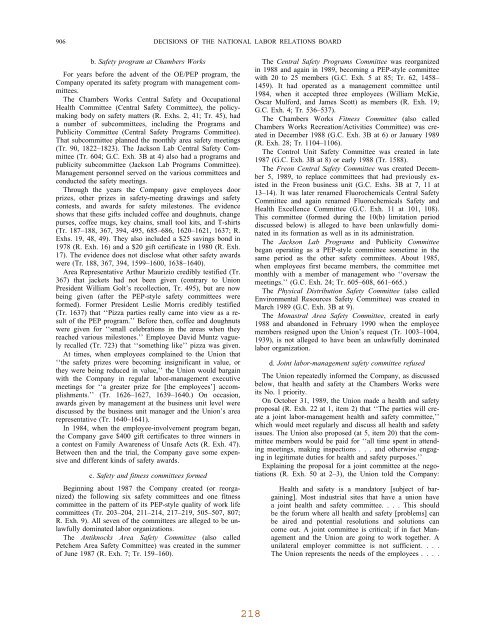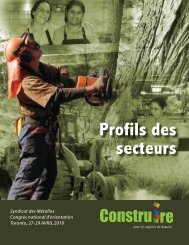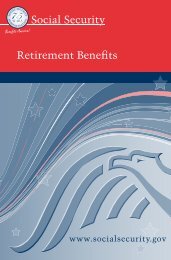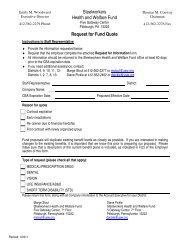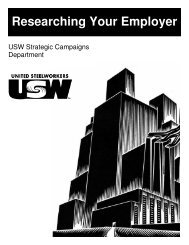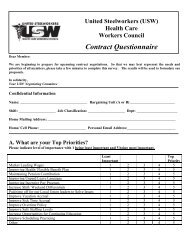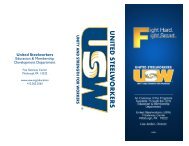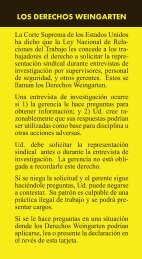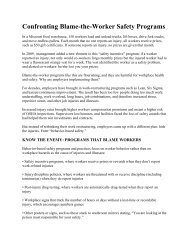Union Approach to Health and Safety: - United Steelworkers
Union Approach to Health and Safety: - United Steelworkers
Union Approach to Health and Safety: - United Steelworkers
You also want an ePaper? Increase the reach of your titles
YUMPU automatically turns print PDFs into web optimized ePapers that Google loves.
906 DECISIONS OF THE NATIONAL LABOR RELATIONS BOARD<br />
b. <strong>Safety</strong> program at Chambers Works<br />
For years before the advent of the OE/PEP program, the<br />
Company operated its safety program with management committees.<br />
The Chambers Works Central <strong>Safety</strong> <strong>and</strong> Occupational<br />
<strong>Health</strong> Committee (Central <strong>Safety</strong> Committee), the policymaking<br />
body on safety matters (R. Exhs. 2, 41; Tr. 45), had<br />
a number of subcommittees, including the Programs <strong>and</strong><br />
Publicity Committee (Central <strong>Safety</strong> Programs Committee).<br />
That subcommittee planned the monthly area safety meetings<br />
(Tr. 90, 1822–1823). The Jackson Lab Central <strong>Safety</strong> Committee<br />
(Tr. 604; G.C. Exh. 3B at 4) also had a programs <strong>and</strong><br />
publicity subcommittee (Jackson Lab Programs Committee).<br />
Management personnel served on the various committees <strong>and</strong><br />
conducted the safety meetings.<br />
Through the years the Company gave employees door<br />
prizes, other prizes in safety-meeting drawings <strong>and</strong> safety<br />
contests, <strong>and</strong> awards for safety miles<strong>to</strong>nes. The evidence<br />
shows that these gifts included coffee <strong>and</strong> doughnuts, change<br />
purses, coffee mugs, key chains, small <strong>to</strong>ol kits, <strong>and</strong> T-shirts<br />
(Tr. 187–188, 367, 394, 495, 685–686, 1620–1621, 1637; R.<br />
Exhs. 19, 48, 49). They also included a $25 savings bond in<br />
1978 (R. Exh. 16) <strong>and</strong> a $20 gift certificate in 1980 (R. Exh.<br />
17). The evidence does not disclose what other safety awards<br />
were (Tr. 188, 367, 394, 1599–1600, 1638–1640).<br />
Area Representative Arthur Maurizio credibly testified (Tr.<br />
367) that jackets had not been given (contrary <strong>to</strong> <strong>Union</strong><br />
President William Golt’s recollection, Tr. 495), but are now<br />
being given (after the PEP-style safety committees were<br />
formed). Former President Leslie Morris credibly testified<br />
(Tr. 1637) that ‘‘Pizza parties really came in<strong>to</strong> view as a result<br />
of the PEP program.’’ Before then, coffee <strong>and</strong> doughnuts<br />
were given for ‘‘small celebrations in the areas when they<br />
reached various miles<strong>to</strong>nes.’’ Employee David Muntz vaguely<br />
recalled (Tr. 723) that ‘‘something like’’ pizza was given.<br />
At times, when employees complained <strong>to</strong> the <strong>Union</strong> that<br />
‘‘the safety prizes were becoming insignificant in value, or<br />
they were being reduced in value,’’ the <strong>Union</strong> would bargain<br />
with the Company in regular labor-management executive<br />
meetings for ‘‘a greater prize for [the employees’] accomplishments.’’<br />
(Tr. 1626–1627, 1639–1640.) On occasion,<br />
awards given by management at the business unit level were<br />
discussed by the business unit manager <strong>and</strong> the <strong>Union</strong>’s area<br />
representative (Tr. 1640–1641).<br />
In 1984, when the employee-involvement program began,<br />
the Company gave $400 gift certificates <strong>to</strong> three winners in<br />
a contest on Family Awareness of Unsafe Acts (R. Exh. 47).<br />
Between then <strong>and</strong> the trial, the Company gave some expensive<br />
<strong>and</strong> different kinds of safety awards.<br />
c. <strong>Safety</strong> <strong>and</strong> fitness committees formed<br />
Beginning about 1987 the Company created (or reorganized)<br />
the following six safety committees <strong>and</strong> one fitness<br />
committee in the pattern of its PEP-style quality of work life<br />
committees (Tr. 203–204, 211–214, 217–219, 505–507, 807;<br />
R. Exh. 9). All seven of the committees are alleged <strong>to</strong> be unlawfully<br />
dominated labor organizations.<br />
The Antiknocks Area <strong>Safety</strong> Committee (also called<br />
Petchem Area <strong>Safety</strong> Committee) was created in the summer<br />
of June 1987 (R. Exh. 7; Tr. 159–160).<br />
The Central <strong>Safety</strong> Programs Committee was reorganized<br />
in 1988 <strong>and</strong> again in 1989, becoming a PEP-style committee<br />
with 20 <strong>to</strong> 25 members (G.C. Exh. 5 at 85; Tr. 62, 1458–<br />
1459). It had operated as a management committee until<br />
1984, when it accepted three employees (William McKie,<br />
Oscar Mulford, <strong>and</strong> James Scott) as members (R. Exh. 19;<br />
G.C. Exh. 4; Tr. 536–537).<br />
The Chambers Works Fitness Committee (also called<br />
Chambers Works Recreation/Activities Committee) was created<br />
in December 1988 (G.C. Exh. 3B at 6) or January 1989<br />
(R. Exh. 28; Tr. 1104–1106).<br />
The Control Unit <strong>Safety</strong> Committee was created in late<br />
1987 (G.C. Exh. 3B at 8) or early 1988 (Tr. 1588).<br />
The Freon Central <strong>Safety</strong> Committee was created December<br />
5, 1989, <strong>to</strong> replace committees that had previously existed<br />
in the Freon business unit (G.C. Exhs. 3B at 7, 11 at<br />
13–14). It was later renamed Fluorochemicals Central <strong>Safety</strong><br />
Committee <strong>and</strong> again renamed Fluorochemicals <strong>Safety</strong> <strong>and</strong><br />
<strong>Health</strong> Excellence Committee (G.C. Exh. 11 at 101, 108).<br />
This committee (formed during the 10(b) limitation period<br />
discussed below) is alleged <strong>to</strong> have been unlawfully dominated<br />
in its formation as well as in its administration.<br />
The Jackson Lab Programs <strong>and</strong> Publicity Committee<br />
began operating as a PEP-style committee sometime in the<br />
same period as the other safety committees. About 1985,<br />
when employees first became members, the committee met<br />
monthly with a member of management who ‘‘oversaw the<br />
meetings.’’ (G.C. Exh. 24; Tr. 605–608, 661–665.)<br />
The Physical Distribution <strong>Safety</strong> Committee (also called<br />
Environmental Resources <strong>Safety</strong> Committee) was created in<br />
March 1989 (G.C. Exh. 3B at 9).<br />
The Monastral Area <strong>Safety</strong> Committee, created in early<br />
1988 <strong>and</strong> ab<strong>and</strong>oned in February 1990 when the employee<br />
members resigned upon the <strong>Union</strong>’s request (Tr. 1003–1004,<br />
1939), is not alleged <strong>to</strong> have been an unlawfully dominated<br />
labor organization.<br />
d. Joint labor-management safety committee refused<br />
The <strong>Union</strong> repeatedly informed the Company, as discussed<br />
below, that health <strong>and</strong> safety at the Chambers Works were<br />
its No. 1 priority.<br />
On Oc<strong>to</strong>ber 31, 1989, the <strong>Union</strong> made a health <strong>and</strong> safety<br />
proposal (R. Exh. 22 at 1, item 2) that ‘‘The parties will create<br />
a joint labor-management health <strong>and</strong> safety committee,’’<br />
which would meet regularly <strong>and</strong> discuss all health <strong>and</strong> safety<br />
issues. The <strong>Union</strong> also proposed (at 5, item 20) that the committee<br />
members would be paid for ‘‘all time spent in attending<br />
meetings, making inspections . . . <strong>and</strong> otherwise engaging<br />
in legitimate duties for health <strong>and</strong> safety purposes.’’<br />
Explaining the proposal for a joint committee at the negotiations<br />
(R. Exh. 50 at 2–3), the <strong>Union</strong> <strong>to</strong>ld the Company:<br />
<strong>Health</strong> <strong>and</strong> safety is a m<strong>and</strong>a<strong>to</strong>ry [subject of bargaining].<br />
Most industrial sites that have a union have<br />
a joint health <strong>and</strong> safety committee. . . . This should<br />
be the forum where all health <strong>and</strong> safety [problems] can<br />
be aired <strong>and</strong> potential resolutions <strong>and</strong> solutions can<br />
come out. A joint committee is critical; if in fact Management<br />
<strong>and</strong> the <strong>Union</strong> are going <strong>to</strong> work <strong>to</strong>gether. A<br />
unilateral employer committee is not sufficient. . . .<br />
The <strong>Union</strong> represents the needs of the employees . ...


